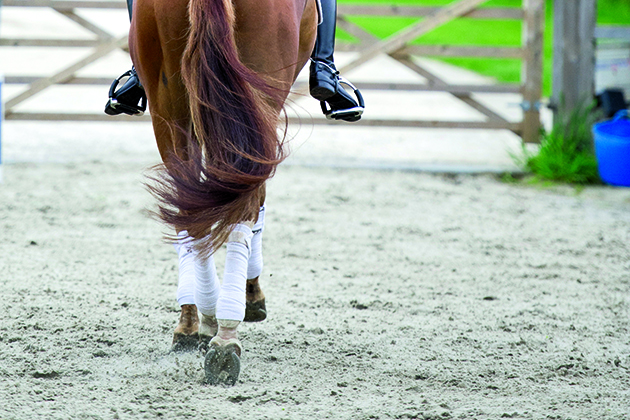When a horse develops a mysterious swelling, you or your vet will be able to recognise what a new lump or bump is just by having a careful look and a thorough feel of the affected area. If not then other diagnostic methods may be required.
A good knowledge of anatomy is helpful here. If you understand what should be present in any particular place, then you should be able to work out if it is that structure that has enlarged or something else that has invaded its space.
{"content":"PHA+QXMgd2VsbCBhcyBvdXIgaG9yc2Vz4oCZIGxpbWJzLCBhbm90aGVyIGFyZWEgdGhhdCBpcyBvZnRlbiBhZmZlY3RlZCBieSBhIG11bHRpdHVkZSBvZiBkaWZmZXJlbnQgbWFzc2VzIGlzIHRoZSBob3JzZeKAmXMgaGVhZCBhbmQgbmVjay48L3A+CjxoMz5HcmFzcyBnbGFuZHM8L2gzPgo8cD5UaGlzIGlzIHRoZSBjbGFzc2ljIGV4YW1wbGUgdGhhdCB3aWxsIHdvcnJ5IG1hbnkgcGVvcGxlIG1vcmUgdGhhbiBpdCBkb2VzIHRoZWlyIGhvcnNlLiBFdmVyeW9uZSB3aWxsIGhhdmUgc2VlbiBpdCBhdCBzb21lIHRpbWUsIHlldCBpdCBpcyBwb29ybHkgdW5kZXJzdG9vZC48L3A+CjxwPkZyZXF1ZW50bHksIGEgaG9yc2Ugb3IgcG9ueSB3aWxsIGJlIGJyb3VnaHQgaW4gZnJvbSB0aGUgZmllbGQgYWZ0ZXIgZ3JhemluZyBmb3Igc29tZSBob3VycyB3aXRoIGxhcmdlLCBmaXJtIGFuZCB1c3VhbGx5IHBhaW5sZXNzIHN3ZWxsaW5ncyBiZWhpbmQgdGhlIGphd2JvbmUgYXQgdGhlIGJhY2sgb2YgdGhlIHRocm9hdCwgYmVuZWF0aCB3aGVyZSB0aGUgdGhyb2F0IGxhc2ggd291bGQgZ28uIE9jY2FzaW9uYWxseSwgdGhlIHN3ZWxsaW5nIHdpbGwgYmUgYWNjb21wYW5pZWQgYnkgc29tZSBmbHVpZCBzd2VsbGluZyB1bmRlciB0aGUgc2tpbi48L3A+CjxwPjxkaXYgY2xhc3M9ImFkLWNvbnRhaW5lciBhZC1jb250YWluZXItLW1vYmlsZSI+PGRpdiBpZD0icG9zdC1pbmxpbmUtMiIgY2xhc3M9ImlwYy1hZHZlcnQiPjwvZGl2PjwvZGl2PjxzZWN0aW9uIGlkPSJlbWJlZF9jb2RlLTMxIiBjbGFzcz0iaGlkZGVuLW1kIGhpZGRlbi1sZyBzLWNvbnRhaW5lciBzdGlja3ktYW5jaG9yIGhpZGUtd2lkZ2V0LXRpdGxlIHdpZGdldF9lbWJlZF9jb2RlIHByZW1pdW1faW5saW5lXzIiPjxzZWN0aW9uIGNsYXNzPSJzLWNvbnRhaW5lciBsaXN0aW5nLS1zaW5nbGUgbGlzdGluZy0tc2luZ2xlLXNoYXJldGhyb3VnaCBpbWFnZS1hc3BlY3QtbGFuZHNjYXBlIGRlZmF1bHQgc2hhcmV0aHJvdWdoLWFkIHNoYXJldGhyb3VnaC1hZC1oaWRkZW4iPg0KICA8ZGl2IGNsYXNzPSJzLWNvbnRhaW5lcl9faW5uZXIiPg0KICAgIDx1bD4NCiAgICAgIDxsaSBpZD0ibmF0aXZlLWNvbnRlbnQtbW9iaWxlIiBjbGFzcz0ibGlzdGluZy1pdGVtIj4NCiAgICAgIDwvbGk+DQogICAgPC91bD4NCiAgPC9kaXY+DQo8L3NlY3Rpb24+PC9zZWN0aW9uPjwvcD4KPHA+QWZmZWN0ZWQgaG9yc2VzIGNhbiBsb29rIHJhdGhlciBsaWtlIGhhbXN0ZXJzIGFuZCBtYXkgYmUgcmVsdWN0YW50IHRvIHdvcmsgd2l0aCB0aGVpciBoZWFkIGRvd24gb24gdGhlIGJpdC4gU3VjaCBsdW1wcyBhcmUgY29tbW9ubHkgbWlzdGFrZW4gZm9yIGEgbWFuaWZlc3RhdGlvbiBvZiB0aGUgZGlzZWFzZSBzdHJhbmdsZXMsIHdoZW4gaW4gZmFjdCB0aGV5IGFyZSBzaW1wbHkgc3dlbGxpbmdzIG9mIHRoZSBwYXJvdGlkIHNhbGl2YXJ5IGdsYW5kcy48L3A+CjxwPlN1Y2ggc3dvbGxlbiBnbGFuZHMgY2FuIHZhcnkgaW4gc2l6ZSBmcm9tIGRheSB0byBkYXkuIFRoZXkgYXJlIG9mdGVuIGxpbmtlZCB3aXRoIHBhcnRpY3VsYXIgYXJlYXMgb2YgZ3JhemluZyBhbmQgYXJlIHN1c3BlY3RlZCB0byBiZSBhIGZvcm0gb2YgYWxsZXJnaWMgcmVhY3Rpb24uPC9wPgo8cD5UaGUgZ2xhbmRzIGVubGFyZ2UgYWZ0ZXIgdGhlIGhvcnNlIGhhcyBiZWVuIG91dCBhdCBncmFzcyBhbmQgbW9zdCByZXR1cm4gdG8gbm9ybWFsIHNpemUgd2l0aGluIDM2aHIgb2YgY29taW5nIGluIHdpdGggbm8gdHJlYXRtZW50LiBJdCBoZWxwcyBpZiBzdWNoIGhvcnNlcywgd2hlbiBhZmZlY3RlZCwgYXJlIGZlZCBmcm9tIGEgaGVpZ2h0IG9uY2UgdGhleSBhcmUgYnJvdWdodCBpbiwgdG8gYWxsb3cgYW55IGFjY3VtdWxhdGlvbiBvZiBmbHVpZCB0byBkcmFpbiBkb3duLjwvcD4KPGRpdiBjbGFzcz0iYWQtY29udGFpbmVyIGFkLWNvbnRhaW5lci0tbW9iaWxlIj48ZGl2IGlkPSJwb3N0LWlubGluZS0zIiBjbGFzcz0iaXBjLWFkdmVydCI+PC9kaXY+PC9kaXY+CjxwPlRoZXJlIGlzIG5vIG5lZWQgdG8gZG8gYW55dGhpbmcgZXhjZXB0IGhhdmUgYSBjYXJlZnVsIGZlZWwgb2YgdGhlIGFyZWEgdG8gY29uZmlybSBpdCBpcyBqdXN0IHN3b2xsZW4gcGFyb3RpZCBnbGFuZHMuIElmIHRoZSBob3JzZSBsb29rcyBpbGwgb3IgdGhlIHN3ZWxsaW5nIHBlcnNpc3RzLCB0YWxrIHRvIHlvdXIgdmV0LjwvcD4KPGgzPkFic2Nlc3NlczwvaDM+CjxwPkFzIHRoZSB2ZXQgZXhhbWluaW5nIGEgc3dlbGxpbmcsIG9mdGVuIHRoZSBtb3N0IGxvZ2ljYWwgdGhpbmcgdG8gZG8gaXMgdG8gc3RpY2sgYSBuZWVkbGUgaW4gdGhlIHN3b2xsZW4gYXJlYSB0byBzZWUgd2hhdCBpcyBpbnNpZGUuIFRoaXMgY2FuIGJlIHF1aXRlIHNpbXBsZSB0byBkbyBpbiBhIHN0YWJsZSB3aXRoIGEgcXVpY2sgY2xpcCBhbmQgY2xlYW4gb2YgdGhlIHN1c3BlY3QgYXJlYSwgYSBzcG90IG9mIGxvY2FsIGFuYWVzdGhldGljIGFuZCBtYXliZSBzZWRhdGlvbiwgdG9nZXRoZXIgd2l0aCByZWFzc3VyYW5jZSBmb3IgdGhlIG1vcmUgc3F1ZWFtaXNoIG93bmVyLjwvcD4KPGRpdiBjbGFzcz0iYWQtY29udGFpbmVyIGFkLWNvbnRhaW5lci0tbW9iaWxlIj48ZGl2IGlkPSJwb3N0LWlubGluZS00IiBjbGFzcz0iaXBjLWFkdmVydCI+PC9kaXY+PC9kaXY+CjxwPklmIHlvdSBhcmUgZGVhbGluZyB3aXRoIGFuIGFic2Nlc3Mgc3VjaCBhcyBpbiBhIGNhc2Ugb2YgPGEgaHJlZj0iaHR0cHM6Ly93d3cuaG9yc2VhbmRob3VuZC5jby51ay9ob3JzZS1jYXJlL3ZldC1hZHZpY2Uvc3RyYW5nbGVzLWluLWhvcnNlcy0zMDU4MjgiPnN0cmFuZ2xlczwvYT4sIHRoZW4gYSBoeXBvZGVybWljIG5lZWRsZSBhbmQgc3lyaW5nZSB3aWxsIGRyYWluIHRoZSBwdXMsIG1ha2luZyB0aGUgaG9yc2UgZmVlbCBiZXR0ZXIgYW5kIHByb3ZpZGluZyBoaXMgb3duZXIgd2l0aCBhIGRpYWdub3NpcywgYWxiZWl0IG9uZSB0aGV5IG1pZ2h0IG5vdCB3YW50LjwvcD4KPHA+V2l0aCBhIG15c3RlcnkgbWFzcyBzdWNoIGFzIGFuIHVudXN1YWwgc3dlbGxpbmcgb24gdGhlIHNpZGUgb2YgdGhlIGZhY2UsIHRoZSBjbGVhciB5ZWxsb3cgdHJhbnNsdWNlbnQgZmx1aWQgYmVpbmcgZHJhaW5lZCBmcm9tIGl0IGlzIHR5cGljYWwgb2YgYSBjb25kaXRpb24gY2FsbGVkIGFuIGVxdWluZSBwYXJhbmFzYWwgc2ludXMgY3lzdC48L3A+CjxkaXYgY2xhc3M9ImFkLWNvbnRhaW5lciBhZC1jb250YWluZXItLW1vYmlsZSI+PGRpdiBpZD0icG9zdC1pbmxpbmUtNSIgY2xhc3M9ImlwYy1hZHZlcnQiPjwvZGl2PjwvZGl2Pgo8cD5UaGVzZSBhcmUgbGFyZ2Ugc3BhY2Utb2NjdXB5aW5nIGxlc2lvbnMgaW4gb3IgYXJvdW5kIHRoZSBzaW51c2VzLiBUaGV5IGNhbiBlYXNpbHkgYmUgY29uZnVzZWQgd2l0aCBzb21lIGZvcm0gb2YgY2FuY2VyLCBidXQgYXJlIGRldmVsb3BtZW50YWwgZGVmZWN0cyB0aGF0IGFyZSBtb3JlIGNvbW1vbiBpbiBob3JzZXMgdGhhbiBhbnkgZm9ybSBvZiBuYXNhbCB0dW1vdXIuPC9wPgo8cD5UaGFua2Z1bGx5LCBtb3N0IGNhc2VzIGFyZSBmYWlybHkgYW1lbmFibGUgdG8gc3VyZ2ljYWwgdHJlYXRtZW50LCBhbHRob3VnaCB0aGUgc3VyZ2VyeSBpdHNlbGYgY2FuIGJlIHJhdGhlciBnb3J5LCBhcyBpdCBpbnZvbHZlcyBjdXR0aW5nIGEgYm9uZSBmbGFwIHRocm91Z2ggdGhlIHNrdWxsIHRvIHBlZWwgYXdheSB0aGUgY3lzdCBmcm9tIGluc2lkZSB0aGUgaGVhZC4gU29tZSBob3JzZXMgYXJlIGxlZnQgd2l0aCBhIGZhY2lhbCBkZWZvcm1pdHksIGJ1dCByZWN1cnJlbmNlIG9mIHRoZSBwcm9ibGVtIGlzIHVubGlrZWx5LCBzbyBhbGwgdGhhdCBzaG93cyBpcyBhIHNtYWxsIGRlbnQgaW4gdGhlIHNrdWxsIGluIG1vc3QgY2FzZXMuPC9wPgo8aDM+T3RoZXIgb3B0aW9uczwvaDM+CjxwPk5lZWRsZSBwdW5jdHVyZSBpcyBhIG5lYXQgaWRlYSwgYnV0IG5vdCB0aGUgc29sdXRpb24gdG8gYWxsIHN3ZWxsaW5ncy4gSWYgc29tZXRoaW5nIGlzIHNvbGlkLCBpdCB3aWxsIG5vdCBiZSBwb3NzaWJsZSB0byBkcmFpbiBpdCwgb3IgaWYgYSBtYXNzIGlzIGJsb29kLWZpbGxlZCwgc3RpY2tpbmcgYSBuZWVkbGUgaW4gbWF5IHJlc3VsdCBpbiBhIG1lc3N5IGhhZW1vcnJoYWdlLCBmb3IgZXhhbXBsZSwgaW4gc29tZSBzd2VsbGluZ3MgaW4gdGhlIHRoeXJvaWQgYXJlYSBvciB3aXRoIHNvbWUgaGFlbWF0b21hcyAoYmxvb2QgYmxpc3RlcnMpLjwvcD4KPHA+QSBmaW5lIG5lZWRsZSBhc3BpcmF0ZSBjYW4gYmUgc3VjY2Vzc2Z1bGx5IHBlcmZvcm1lZCBvbiBzb21lIHNvbGlkIGx1bXBzLiBUaGUgYWltIGlzIHRvIGNvbGxlY3Qgc29tZSBjZWxscyB0aGF0IGNhbiBiZSBleGFtaW5lZCBtaWNyb3Njb3BpY2FsbHkuIElmIHRoYXQgaXMgaW5zdWZmaWNpZW50LCBhIGJpb3BzeSB3aXRoIGEgc3BlY2lhbGx5IGRlc2lnbmVkIGxhcmdlciBuZWVkbGUgY2FuIHdvcmsgd2VsbC4gUGFydCBvZiB0aGUgYXJ0IG9mIHZldGVyaW5hcnkgbWVkaWNpbmUgaXMga25vd2luZyB3aGVuIGl0IGlzIHNhZmUgdG8gYmUgaW52YXNpdmUgYW5kIHdoZW4gaXQgaXMgYmV0dGVyIHRvIHdhaXQgYW5kIHNlZS48L3A+CjxkaXYgY2xhc3M9ImluamVjdGlvbiI+PC9kaXY+CjxwPlVsdHJhc291bmQgY2FuIHByb3ZpZGUgdGhlIGFuc3dlciB3aGVuIG9uZSBpcyB1bnN1cmU6IGluIHRoZSBzYW1lIHdheSB0aGF0IHRoaXMgY2FuIHByb3ZpZGUgY2xlYXIgaW1hZ2VzIG9mIHRoZSBiYWJ5IGluc2lkZSBhIHByZWduYW50IHdvbWFuLCBpdCBjYW4gYWxzbyByZXZlYWwgd2hhdCBpcyBpbnNpZGUgbW9zdCBzb2Z0IHRpc3N1ZSBzd2VsbGluZ3Mgd2l0aCBtaW5pbWFsIGRpc3RyZXNzIHRvIHRoZSBob3JzZS4gSWYgdGhlIHN3ZWxsaW5nIGlzIGJvbnksIFgtcmF5cyBtYXkgYmUgcmVxdWlyZWQgdG8gcHJvdmlkZSB0aGUgYW5zd2VyLjwvcD4KPHA+VGhlIG9jY2FzaW9uYWwgY2FzZSBtYXkgbmVlZCBhbGwgdGhpcyBhbmQgZXZlbiBtb3JlIDIxc3QgY2VudHVyeSB0ZWNobm9sb2d5IHN1Y2ggYXMgQ0FUIChjb21wdXRlcmlzZWQgYXhpYWwgdG9tb2dyYXBoeSkgc2NhbnMgb3IgTVJJIChtYWduZXRpYyByZXNvbmFuY2UgaW1hZ2luZyksIGJ1dCBldmVuIG5vdyBtb3N0IGNhbiBiZSBkaWFnbm9zZWQgd2l0aCBnb29kIGFuYXRvbWljYWwga25vd2xlZGdlLCBhIG5lZWRsZSwgc3lyaW5nZSBhbmQgc3VmZmljaWVudCBleHBlcnRpc2UuPC9wPgo8cD48ZW0+SG9yc2UgJmFtcDsgSG91bmQgKDIxIERlY2VtYmVyLCAmIzgyMTc7MDYpPC9lbT48L3A+CjxwPgo="}
You may also be interested in…
Credit: no credit
Library image.
Credit: Lucy Merrell
Credit: Lucy Merrell
A leg wound showing proud flesh on a horse’s hind leg




